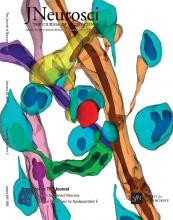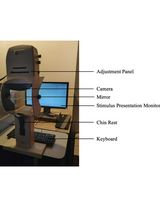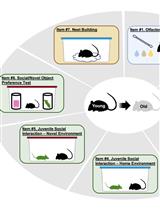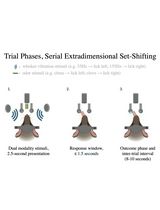- EN - English
- CN - 中文
Apparatus and General Methods for Exposing Rats to Audiogenic Stress
音源性应激试验(大鼠)
发布: 2016年11月05日第6卷第21期 DOI: 10.21769/BioProtoc.1994 浏览次数: 6949
评审: Soyun KimManuel SarmientoAnonymous reviewer(s)
Abstract
Most organisms react innately to the sudden onset of environmental stimulation. Audiogenic or loud noise in rodents provides an effective threatening signal to study the central nervous circuits responsible for the elaboration of various responses typically elicited by threatening/stressful environmental stimulation. Audiogenic stress offers many advantages over other environmental stimulation, including exquisite control over timing, intensity, and frequency, using off-the-shelf components that produce easily reproducible results. This protocol provides blueprints for the construction of sound attenuation chambers, the associated sound generation, amplification, and delivery equipment, and general procedures sufficient to elicit multimodal responses to loud noises in rodents.
Background
For many years, audiogenic stress (loud noise) has been employed as an effective stimulus to activate multimodal responses traditionally associated with threatening situations and stressor exposures, including the neuroendocrine hypothalamo-pituitary-adrenocortical (HPA) axis (as indexed by the release of glucocorticoids and adrenocorticotropin hormone - ACTH; [Borrell et al., 1980; Campeau and Watson, 1997; Henkin and Knigge, 1963; Segal et al., 1989]), the autonomic system (as measured by peripheral catecholamine release, heart rate, blood pressure, or core body temperature measurements; [Bao et al., 1999; De Boer et al., 1989; Gamallo et al., 1992; Masini et al., 2008; Overton et al., 1991; Saha et al., 1996]), and a multiphase behavioral reaction which initially elicits forceful, quick evasive locomotor responses, followed within a few minutes by significant reduction or inhibition of locomotor activity, feeding, and drinking (Britton et al.,1992; Campeau and Watson, 1997; Irwin et al., 1989; Masini et al., 2008; Segal et al., 1989). These powerful effects of loud sounds likely arise from the fact that such high intensity auditory stimulation are frequently associated with environmental events occurring very close to the listener that require immediate, life-saving attention (predator pouncing, objects falling or traveling at a high rate of speed, etc.). The importance of these emergency responses is further suggested by their similarities across a wide array of species and environments (aquatic, terrestrial, airborne).
Compared to many stress protocols, audiogenic stress has a number of advantageous characteristics, and the current protocol has some advantages compared to previous audiogenic stress protocols (Siegel et al., 1983; Boadle-Biber et al., 1989). Perhaps the single most important advantage of audiogenic stress is its exquisite control over the amplitude of acoustic stimulation, providing one of the few procedures for which the intensity of the stressor can be controlled along a continuum of innocuous auditory intensities to increasingly stressful exposures (Boadle-Biber et al., 1989; Campeau and Watson, 1997; Burow et al., 2005), as compared to other popular stressor protocols such as restraint, immobilization, tail suspension, social stress, and others. And whereas several previous loud noise protocols exposed multiple rats to loud noise in the same enclosure (Boadle-Biber et al., 1989) or individually but in large rooms (Siegel et al., 1983), the current protocol was developed to expose animals to noise independently, increasing the likelihood for reproducibility in exposed and control rats simultaneously. As described below, the procedures developed in our laboratory for exposure of rats to audiogenic stress allows the simultaneous measurement of multiple responses, which is necessary to study the integrated mechanisms necessary to understand the elaboration of multimodal responses to stress.
Materials and Reagents
- Sprague-Dawley rats (6-12 weeks of age) from Envigo (Enrigo, catalog number: Sprague-Dawley® outbred rats )
- Rat chow (Enrigo, catalog number: Teklad global 14% protein #2014 )
Equipment
- The sound attenuating enclosures (constructed from double wooden [2 cm plywood board] boxes)
- Outer box [external dimensions: 85 (w) x 60 (d) x 72 (h) cm] lined internally with 2.5 cm insulation (CelotexTM) (Figures 1A to 1D)
- Inner box [internal dimensions: 60 (w) x 38 (d) x 38 (h) cm] (allows placement of a polycarbonate rat home cage inside, including food and water for overnight housing – Figures 1C, 1E, 1H, and 1I)
- All these general construction materials can be procured in local hardware stores.
- Cooling fans, 105 cm (General Wireless Operation, RadioShack, model: 2730241 ) (Figures 1A and 1B)
- Car speakers, 15.25 x 22.85 cm (RadioShack Corporation, model: 12-1769 – 120 W RMS ) (Figures 1E and 1H)
- Fluorescent lamps (n: VISION, model: EDX0-14, 14 W, soft white; EcoSmart, catalog number: 423-599 ) (Figures 1E and 1H)
- Noise generator (General Radio, model: 1381 ) (Figure 1F)
- Band-pass filter (Krohn-Hite, model: 3100R )
- Power amplifiers (PropertyRoom, model: Pyramid Studio Pro PA-600X ) (Figure 1G)
- Sound level meter (RadioShack, model: 33-2050 – A scale) (Figures 1I and 1J)
Notes: - Some of the equipment discussed above can only be obtained from secondary sources. When possible, links to specifications sheets are provided to help in obtaining more recent equipment with similar characteristics.
- Animals are exposed to loud noise within individual sound attenuating chambers in an independent room, away from the general vivarium to ensure that only experimental animals experience the loud acoustic stimulation.
- The internal dimensions of individual sound attenuating chamber allows placement of a polycarbonate rat home cage inside, including food and water for overnight housing (see Figures 1E, 1H, and 1I).
- Each box is fitted with two 105 cm cooling fans, located in the lower back left (push air in), and upper front right side (draw air out) of the external box, respectively, to provide a constant flow of fresh air (65 CFM) inside each box (see Figures 1A and 1B).
- Each enclosure provides approximately 30 dBA (sound pressure level – SPL, A scale) of sound attenuation, which allows the testing of both loud noise and no noise experimental subjects simultaneously in adjacent enclosures.
- Each enclosure is fitted with a single Optimus speaker fixed in the middle of the ceiling of the internal enclosure (see Figures 1E and 1H). Speaker characteristics permit sound delivery between 20 and 27,000 Hz, with the intensity rolling off quickly (20 dB octave) at both ends of the frequency spectrum.
- Lighting is provided by a fluorescent lamp located in the upper left corner of the internal enclosure (see Figures 1E and 1H), which are kept on the same day-night cycle as the lighting of the main colony room.
- Noise is produced by a General Radio solid-state random-noise generator with the bandwidth set at 2-50,000 Hz for most of the experiments (see Figure 1F). Frequencies can be filtered through a Krohn-Hite filter to achieve different band-pass settings when necessary. The output of the noise generator is generally fed to power amplifiers (Pyramid Studio Pro [see Figure 1G]), the outputs of which are connected to the Optimus speakers.
- Noise intensity is measured by placing a Sound Level Meter in an empty rat’s home cage at several locations and taking an average of the different readings (see Figure 1I). The noise level provided by the ventilating fans is approximately 57 dBA, which is defined as the ‘no noise’ or ‘background/ambient noise’ level. The noise level in the quiet animal colony averages approximately 55 dBA.
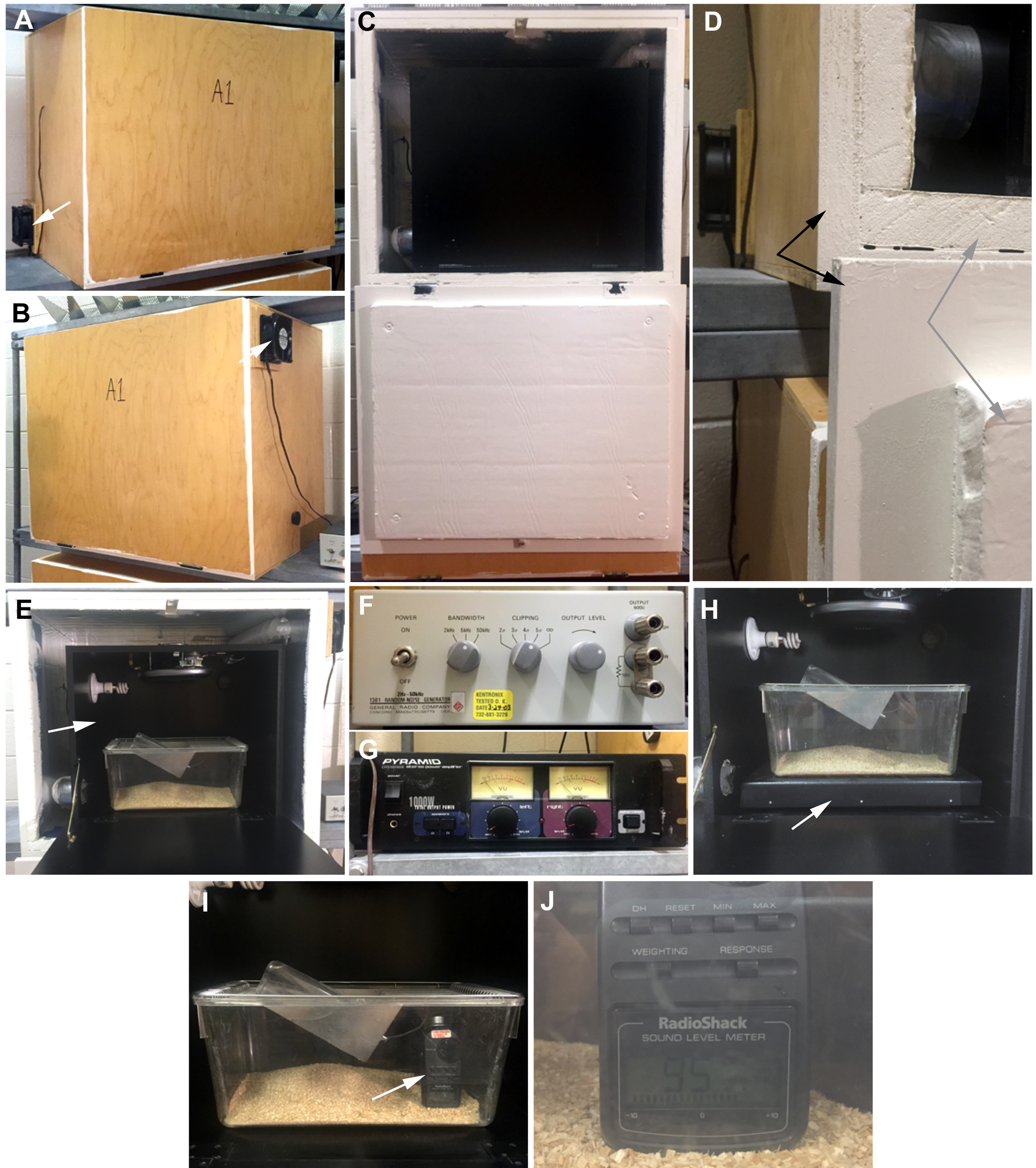
Figure 1. Representative images of equipment. Views of the external enclosure from the left angle (A) and right angle (B), showing the location of the fans (white arrows) to provide continuous fresh air internally. C. View of the open external enclosure and the internal closed enclosure. D. Detailed view of the external enclosure construction, with the 2-cm plywood panel (black arrows) lined internally with 2.5-cm celotex material, which also covers the hinged door (gray arrows). E. View of the open internal enclosure (white arrow) fitted with an empty home cage for demonstration purposes, and the location of the light and speaker (see also H below). The home cage sits directly under the speaker (see also H below). F. Front view of the General Radio #1381 noise generator employed to generate sound. G. Front view of the Pyramid Studio Pro PA-600X amplifier employed to amplify the sound from the noise generator. H. Additional view of the open internal enclosure fitted with Starr Life Sciences’ ER4000 Receiver antenna (white arrow). A rat’s home cage sits directly on top of the ER4000 to telemetrically provide heart rate, core body temperature, and general locomotor activity information when rats are implanted with PDT 4000 HR Emitters. I. View of the RadioShack sound level meter (white arrow) employed to measure sound pressure levels inside a rat’s home cage during sound delivery. The meter is moved in different home cage locations to verify the desired averaged SPL. J. Larger view of the sound pressure level display (95 dBA) during a sound test.
Procedure
文章信息
版权信息
© 2016 The Authors; exclusive licensee Bio-protocol LLC.
如何引用
Campeau, S. (2016). Apparatus and General Methods for Exposing Rats to Audiogenic Stress. Bio-protocol 6(21): e1994. DOI: 10.21769/BioProtoc.1994.
分类
神经科学 > 行为神经科学 > 认知
您对这篇实验方法有问题吗?
在此处发布您的问题,我们将邀请本文作者来回答。同时,我们会将您的问题发布到Bio-protocol Exchange,以便寻求社区成员的帮助。
提问指南
+ 问题描述
写下详细的问题描述,包括所有有助于他人回答您问题的信息(例如实验过程、条件和相关图像等)。
Share
Bluesky
X
Copy link



